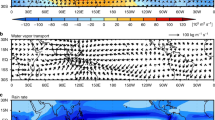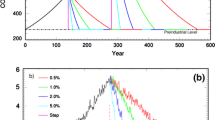Abstract
Atmospheric CO2 removal is currently receiving serious consideration as a supplement or even alternative to emissions reduction. However the possible consequences of such a strategy for the climate system, and particularly for regional changes to the hydrological cycle, are not well understood. Two idealised general circulation model experiments are described, where CO2 concentrations are steadily increased, then decreased along the same path. Global mean precipitation continues to increase for several decades after CO2 begins to decrease. The mean tropical circulation shows associated changes due to the constraint on the global circulation imposed by precipitation and water vapour. The patterns of precipitation and circulation change also exhibit asymmetries with regard to changes in both CO2 and global mean temperature, but while the lag in global precipitation can be ascribed to different levels of CO2 at the same temperature state, the regional changes cannot. Instead, ocean memory and heat transfer are important here. In particular the equatorial East Pacific continues to warm relative to the West Pacific during CO2 ramp-down, producing an anomalously large equatorial Pacific sea surface temperature gradient and associated rainfall anomalies. The mechanism is likely to be a lag in response to atmospheric forcing between mixed-layer water in the east Pacific and the sub-thermocline water below, due to transport through the ocean circulation. The implication of this study is that a CO2 pathway of increasing then decreasing atmospheric CO2 concentrations may lead us to climate states during CO2 decrease that have not been experienced during the increase.















Similar content being viewed by others
References
Andrews T, Forster PM, Gregory JM (2009) A surface energy perspective on climate change. J Climate 22(10):2557–2570
Andrews T, Forster PM, Boucher O, Bellouin N, Jones A (2010) Precipitation, radiative forcing and global temperature change. Geophys Res Lett 37(L14701)
Bain CL, De Paz J, Kramer J, Magnusdottir G, Smyth P, Stern H, Wang C-C (2011) Detecting the ITCZ in instantaneous satellite data using spatiotemporal statistical modeling: ITCZ climatology in the East Pacific. J Climate 24(1):216–230
Bala G, Duffy PB, Taylor KE (2008) Impact of geoengineering schemes on the global hydrological cycle. PNAS 105(22):7664–7669
Bala G, Caldeira K, Nemani R (2010) Fast versus slow response in climate change: implications for the global hydrological cycle. Clim Dyn 35(2–3):423–434
Barsugli JJ, Shin SI, Sardeshmukh PD (2006) Sensitivity of global warming to the pattern of tropical ocean warming. Clim Dyn 27(5):483–492
Boucher O, Burke E, Doutriaux-Boucher M, Halloran P, Jones CD, Lowe J, Ringer MA, Wu P (2011) Is the Earth System reversible to climate change? (submitted)
Cao L, Bala G, Caldeira K (2011) Why is there a short-term increase in global precipitation in response to diminished CO2 forcing? Geophys Res Lett 38(L06703)
Chiang JC, Bitz CM (2005) Influence of high latitude ice cover on the marine intertropical convergence zone. Clim Dyn 25:477–496
Chiang JC, Fang Y, Chang P (2008) Interhemispheric thermal gradient and tropical Pacific climate. Geophys Res Lett 35(L14704)
Chou C, Neelin J (2004) Mechanisms of global warming impacts on regional tropical precipitation. J Climate 17(13):2688–2701
Chou C, Neelin JD, Chen CA, Tu JY (2009) Evaluating the “Rich-Get-Richer” mechanism in tropical precipitation change under global warming. J Climate 22(8):1982–2005
Clement A, Seager R, Cane M, Zebiak S (1996) An ocean dynamical thermostat. J Climate 9(9):2190–2196
Collins M, An SI, Cai W, Ganachaud A, Guilyardi E, Jin FF, Jochum M, Lengaigne M, Power S, Timmermann A, Vecchi G, Wittenberg A (2010) The impact of global warming on the tropical Pacific ocean and El Nino. Nat Geosci 3(6):391–397
Collins W, Bellouin N, Doutriaux-Boucher M, Gedney N, Halloran P, Hinton T, Hughes J, Jones C, Joshi M, Liddicoat S, Martin G, O’Connor F, Rae J, Senior C, Sitch S, Totterdell I, Wiltshire A, Woodward S (2011) Development and evaluation of an earth-system model—HadGEM2 (submitted to Geosci Model Dev)
DiNezio PN, Clement AC, Vecchi GA, Soden BJ, Kirtman BP (2009) Climate response of the equatorial pacific to global warming. J Climate 22(18):4873–4892
Gastineau G, Le Treut H, Li L (2008) Hadley circulation changes under global warming conditions indicated by coupled climate models. Tellus ser A- Dyn Meteorol Oceanogr 60(5):863–884
Gastineau G, Li L, Le Treut H (2009) The Hadley and Walker circulation changes in global warming conditions described by idealized atmospheric simulations. J Climate 22(14):3993–4013
Good P, Gregory JM, Lowe JA (2011a) A step-response simple climate model to reconstruct and interpret AOGCM projections. Geophys Res Lett 38(L01703)
Good P, Ingram W, Lambert FH, Lowe JA, Gregory JM, Webb MJ, Ringer MA, Wu P (2011b) A step-response simple climate model for predicting and understanding precipitation from global to regional scales (submitted)
Gordon C, Cooper C, Senior C, Banks H, Gregory J, Johns T, Mitchell J, Wood R (2000) The simulation of SST, sea ice extents and ocean heat transports in a version of the Hadley Centre coupled model without flux adjustments. Clim Dyn 16(2–3):147–168
Hansen J, Sato M, Ruedy R, Nazarenko L, Lacis A, Schmidt G, Russell G, Aleinov I, Bauer M, Bauer S, Bell N, Cairns B, Canuto V, Chandler M, Cheng Y, Del-Genio A, Faluvegi G, Fleming E, Friend A, Hall T, Jackman C, Kelley M, Kiang N, Koch D, Lean J, Lerner J, Lo K, Menon S, Miller R, Minnis P, Novakov T, Oinas V, Perlwitz J, Perlwitz J, Rind D, Romanou A, Shindell D, Stone P, Sun S, Tausnev N, Thresher D, Wielicki B, Wong T, Yao M, Zhang S (2005) Efficacy of climate forcings. J Geophys Res Atmos 110(D18104)
Held IM, Soden BJ (2006) Robust responses of the hydrological cycle to global warming. J Climate 19(21):5686–5699
Held IM, Winton M, Takahashi K, Delworth T, Zeng F, Vallis GK (2010) Probing the fast and slow components of global warming by returning abruptly to preindustrial forcing. J Climate 23(9):2418–2427
Jones A, Haywood J, Boucher O, Kravitz B, Robock A (2010) Geoengineering by stratospheric SO(2) injection: results from the Met Office HadGEM(2) climate model and comparison with the Goddard Institute for Space Studies ModelE. Atmos Chem Phys 10(13):5999–6006
Karnauskas KB, Seager R, Kaplan A, Kushnir Y, Cane MA (2009) Observed strengthening of the zonal sea surface temperature gradient across the Equatorial Pacific Ocean. J Climate 22(16):4316–4321
Knutson T, Manabe S (1995) Time-mean response over the tropical Pacific to increased CO2 in a coupled ocean-atmosphere model. J Climate 8(9):2181–2199
Liu Z, Vavrus S, He F, Wen N, Zhong Y (2005) Rethinking tropical ocean response to global warming: the enhanced equatorial warming. J Climate 18(22):4684–4700
Lloyd J, Guilyardi E, Weller H, Slingo J (2009) The role of atmosphere feedbacks during ENSO in the CMIP3 models. Atmos Sci Lett 10(3, SI):170–176
Martin GM, Bellouin N, Collins WJ, Culverwell ID, Halloran PR, Hardiman SC, Hinton TJ, Jones CD, McDonald RE, McLaren AJ, O’Connor FM, Roberts MJ, Rodriguez JM, Woodward S, Best MJ, Brooks ME, Brown AR, Butchart N, Dearden C, Derbyshire SH, Dharssi I, Doutriaux-Boucher M, Edwards JM, Falloon PD, Gedney N, Gray LJ, Hewitt HT, Hobson M, Huddleston MR, Hughes J, Ineson S, Ingram WJ, James PM, Johns TC, Johnson CE, Jones A, Jones CP, Joshi MM, Keen AB, Liddicoat S, Lock AP, Maidens AV, Manners JC, Milton SF, Rae JGL, Ridley JK, Sellar A, Senior CA, Totterdell IJ, Verhoef A, Vidale PL, Wiltshire A (2011) The HadGEM2 family of Met Office unified model climate configurations (to Geosci Model Dev)
Matei D, Keenlyside N, Latif M, Jungclaus J (2008) Subtropical forcing of tropical Pacific climate and decadal ENSO modulation. J Climate 21(18):4691–4709
McCreary J, Lu P (1994) Interaction between the subtropical and equatorial ocean circulations—the subtropical cell. J Phys Oceanogr 24(2):466–497
McPhaden M, Zhang D (2002) Slowdown of the meridional overturning circulation in the upper Pacific Ocean. Nat 415(6872):603–608
Mitchell J, Wilson C, Cunnington W (1987) On CO2 climate sensitivity and model dependence of results. QJRMS 113(475):293–322
Pennell C, Reichler T (2011) On the effective number of climate models. J Climate 24(9):2358–2367
Ricke KL, Morgan G, Allen MR (2010) Regional climate response to solar-radiation management. Nat Geosci 3(8):537–541
Robock A, Oman L, Stenchikov GL (2008) Regional climate responses to geoengineering with tropical and Arctic SO2 injections. J Geophys Res-Atmospheres 113(D16101)
Schubert S, Suarez M, Pegion P, Koster R, Bacmeister J (2004) On the cause of the 1930s Dust Bowl. Sci 303(5665):1855–1859
Seager R, Murtugudde R (1997) Ocean dynamics, thermocline adjustment, and regulation of tropical SST. J Climate 10(3):521–534
Seager R, Naik N, Vecchi GA (2010) Thermodynamic and dynamic mechanisms for large-scale changes in the hydrological cycle in response to global warming. J Climate 23(17):4651–4668
Stouffer R (2004) Time scales of climate response. J Climate 17(1):209–217
Sugi M, Yoshimura J (2004) A mechanism of tropical precipitation change due to CO2 increase. J Climate 17(1):238–243
Trenberth K, Stepaniak D, Caron J (2000) The global monsoon as seen through the divergent atmospheric circulation. J Climate 13(22):3969–3993
Vecchi G, Soden B, Wittenberg A, Held I, Leetmaa A, Harrison M (2006) Weakening of tropical Pacific atmospheric circulation due to anthropogenic forcing. Nat 441(7089):73–76
Vecchi GA, Soden BJ (2007) Global warming and the weakening of the tropical circulation. J Climate 20(17):4316–4340
Wu L, Liu Z, Gallimore R, Jacob R, Lee D, Zhong Y (2003) Pacific decadal variability: The tropical Pacific mode and the North Pacific mode. J Climate 16(8):1101–1120
Wu P, Wood R, Ridley J, Lowe J (2010) Temporary acceleration of the hydrological cycle in response to a CO2 rampdown. Geophys Res Lett 37(L12705)
Xie SP, Deser C, Vecchi GA, Ma J, Teng H, Wittenberg AT (2010) Global warming pattern formation: sea surface temperature and rainfall. J Climate 23(4):966–986
Yang H, Zhu J (2011) Equilibrium thermal response timescale of global oceans. Geophys Res Lett 38(L14711)
Zhang M, Song H (2006) Evidence of deceleration of atmospheric vertical overturning circulation over the tropical Pacific. Geophys Res Lett 33(12)
Acknowledgments
The authors were supported by the Joint Department of Energy and Climate Change (DECC) and Department for Environment, Food and Rural Affairs (Defra) Met Office Hadley Centre Climate Programme, DECC/Defra (GA01101). We would like to thank Marie Boucher-Boucher for providing the HadGEM2-ES ramp-up/ramp-down data. Thanks also to Mark Ringer, Gill Martin and Graeme Stephens for useful discussions, and to two anonymous reviewers for helpful comments.
Author information
Authors and Affiliations
Corresponding author
Rights and permissions
About this article
Cite this article
Chadwick, R., Wu, P., Good, P. et al. Asymmetries in tropical rainfall and circulation patterns in idealised CO2 removal experiments. Clim Dyn 40, 295–316 (2013). https://doi.org/10.1007/s00382-012-1287-2
Received:
Accepted:
Published:
Issue Date:
DOI: https://doi.org/10.1007/s00382-012-1287-2




